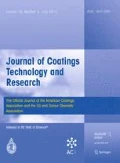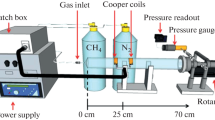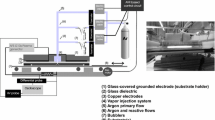Abstract
Octafluorocyclobutane and acrylic acid (C4F8-co-AA) are plasma copolymerized onto low-density polyethylene (LDPE) and glass slides under various pulsation periods of radio frequency pulsed plasma. The surface wettability of plasma polymer coating is traditionally considered as a substrate-independent property. The combined effect of ultrathin C4F8-co-AA coatings and LDPE substrate on surface wettability is presented. The high concentration of the carboxylic acid functional groups gives rise to hydrophilicity via lowering duty cycle, and substrate impact gives rise to hydrophobicity for ultrathin coatings. The X-ray photoelectron spectroscopy and coating thickness measurements confirmed that the sudden increase in water contact angle for the lower duty cycle is influenced by the hydrophobic substrate for ultrathin polymer coatings. It is highlighted that the precise control over the surface wettability is attained by tuning the plasma parameters. The substrate-dependent wettability for flat substrate persisted for longer than 8 weeks, which demonstrates wetting stability for ultrathin coatings.










Similar content being viewed by others
Data availability
The raw/processed data required to reproduce these findings cannot be shared at this time as the data also forms part of an ongoing study.
References
Yao, X, Song, Y, Jiang, L, “Applications of Bio-inspired Special Wettable Surfaces.” Adv. Mater., 23 719–734 (2011). https://doi.org/10.1002/adma.201002689
Muzammil, I, Dinh, DK, Abbas, Q, Imran, M, Sattar, H, Ahmad, AU, “Controlled Surface Wettability by Plasma Polymer Surface Modification.” Surfaces, 2 349–371 (2019). https://doi.org/10.3390/surfaces2020026
Falde, EJ, Yohe, ST, Colson, YL, Grinstaff, MW, “Superhydrophobic Materials for Biomedical Applications.” Biomaterials, 104 87–103 (2016). https://doi.org/10.1016/j.biomaterials.2016.06.050
Li, XM, Reinhoudt, D, Crego-Calama, M, “What Do We Need for a Superhydrophobic Surface? A Review on the Recent Progress in the Preparation of Superhydrophobic Surfaces.” Chem. Soc. Rev., 36 1350–1368 (2007). https://doi.org/10.1039/b602486f
Liu, K, Yao, X, Jiang, L, “Recent Developments in Bio-inspired Special Wettability.” Chem. Soc. Rev., 39 3240–3255 (2010). https://doi.org/10.1039/b917112f
Lafuma, A, Quere, D, “Superhydrophobic States.” Nat. Mater., 2 457–460 (2003)
Chow, PK, Singh, E, Viana, BC, Gao, J, Luo, J, Li, J, Lin, Z, Elías, AL, Shi, Y, Wang, Z, Terrones, M, Koratkar, N, “Wetting of Mono and Few-Layered WS2 and MoS2 Films Supported on Si/SiO2 Substrates.” ACS Nano, 9 3023–3031 (2015). https://doi.org/10.1021/nn5072073
Choi, BK, Lee, IH, Kim, J, Chang, YJ, “Tunable Wetting Property in Growth Mode-Controlled WS2 Thin Films.” Nanoscale Res. Lett., 12 262 (2017). https://doi.org/10.1186/s11671-017-2030-z
Li, J, Wei, M, Wang, Y, “Substrate Matters: The Influences of Substrate Layers on the Performances of Thin-film Composite Reverse Osmosis Membranes.” Chin. J. Chem. Eng., 25 1676–1684 (2017). https://doi.org/10.1016/j.cjche.2017.05.006
Shih, C-J, Strano, MS, Blankschtein, D, “Wetting Translucency of Graphene.” Nat. Mater., 12 866–869 (2013). https://doi.org/10.1038/nmat3760
Muzammil, I, Li, Y, Lei, M, “Tunable Wettability and pH-Responsiveness of Plasma Copolymers of Acrylic Acid and Octafluorocyclobutane.” Plasma Process. Polym., 14 1700053 (2017). https://doi.org/10.1002/ppap.201700053
Kim, MS, Khang, G, Lee, HB, “Gradient Polymer Surfaces for Biomedical Applications.” Prog. Polym. Sci., 33 138–164 (2008). https://doi.org/10.1016/j.progpolymsci.2007.06.001
Chan, CM, Ko, TM, Hiraoka, H, “Polymer Surface Modification by Plasmas and Photons.” Surf. Sci. Rep., 24 3–54 (1996)
Muzammil, I, Li, Y, Lei, M, “Cover Picture: Multifunctional Smart Polymer Coatings 10/2017.” Plasma Process. Polym., 14 1770019 (2017). https://doi.org/10.1002/ppap.201770019
Siffer, F, Ponche, A, Fioux, P, Schultz, J, Roucoules, V, “A Chemometric Investigation of the Effect of the Process Parameters During Maleic Anhydride Pulsed Plasma Polymerization.” Anal. Chim. Acta, 539 289–299 (2005). https://doi.org/10.1016/j.aca.2005.02.072
Förch, R, Zhang, Z, Knoll, W, “Soft Plasma Treated Surfaces: Tailoring of Structure and Properties for Biomaterial Applications.” Plasma Process. Polym., 2 351–372 (2005). https://doi.org/10.1002/ppap.200400083
Friedrich, J, “Pulsed-Plasma Polymerization.” In: The Plasma Chemistry of Polymer Surfaces, pp. 377–456. Wiley-VCH Verlag GmbH & Co. KGaA, 2012. https://doi.org/10.1002/9783527648009.ch12.
Muzammil, I, Li, YP, Li, XY, Lei, MK, “Duty Cycle Dependent Chemical Structure and Wettability of RF Pulsed Plasma Copolymers of Acrylic Acid and Octafluorocyclobutane.” Appl. Surf. Sci., 436 411–418 (2018). https://doi.org/10.1016/j.apsusc.2017.11.261
Daw, R, O’Leary, T, Kelly, J, Short, RD, Cambray-Deakin, M, Devlin, AJ, Brook, IM, Scutt, A, Kothari, S, “Molecular Engineering of Surfaces by Plasma Copolymerization and Enhanced Cell Attachment and Spreading.” Plasmas Polym., 4 113–132 (1999). https://doi.org/10.1023/A:1021844824801
France, RM, Short, RD, Duval, E, Jones, FR, Dawson, RA, MacNeil, S, “Plasma Copolymerization of Allyl Alcohol/1,7-Octadiene: Surface Characterization and Attachment of Human Keratinocytes.” Chem. Mater., 10 1176–1183 (1998). https://doi.org/10.1021/cm970761+
Friedrich, J, Mix, R, Kühn, G, Retzko, I, Schönhals, A, Unger, W, “Plasma-Based Introduction of Monosort Functional Groups of Different Type and Density onto Polymer Surfaces. Part 2: Pulsed Plasma Polymerization.” Compos. Interfaces, 10 173–223 (2003). https://doi.org/10.1163/156855403765826874
Hirotsu, T, Tagaki, C, Partridge, A, “Plasma Copolymerization of Acrylic Acid with Hexamethyldisilazane.” Plasmas Polym., 7 353–366 (2002). https://doi.org/10.1023/A:1021333120098
Bhatt, S, Pulpytel, J, Ceccone, G, Lisboa, P, Rossi, F, Kumar, V, Arefi-Khonsari, F, “Nanostructure Protein Repellant Amphiphilic Copolymer Coatings with Optimized Surface Energy by Inductively Excited Low Pressure Plasma.” Langmuir, 27 14570–14580 (2011). https://doi.org/10.1021/la203256w
Chahine, C, Poncin-Epaillard, F, Debarnot, D, “Plasma Copolymerization of Fluorinated and Acrylate Monomers: Kinetics and Chemical Structure Study.” Plasma Process. Polym., 12 493–501 (2015). https://doi.org/10.1002/ppap.201400128
Rodriguez-Emmenegger, C, Kylián, O, Houska, M, Brynda, E, Artemenko, A, Kousal, J, Alles, AB, Biederman, H, “Substrate-Independent Approach for the Generation of Functional Protein Resistant Surfaces.” Biomacromolecules, 12 1058–1066 (2011). https://doi.org/10.1021/bm101406m
Teare, DOH, Schofield, WCE, Roucoules, V, Badyal, JPS, “Substrate-Independent Growth of Micropatterned Polymer Brushes.” Langmuir, 19 2398–2403 (2003). https://doi.org/10.1021/la020279s
Voronin, SA, Zelzer, M, Fotea, C, Alexander, MR, Bradley, JW, “Pulsed and Continuous Wave Acrylic Acid Radio Frequency Plasma Deposits: Plasma and Surface Chemistry.” J. Phys. Chem. B, 111 3419–3429 (2007). https://doi.org/10.1021/jp068488z
Vasilev, K, Michelmore, A, Griesser, HJ, Short, RD, “Substrate Influence on the Initial Growth Phase of Plasma-Deposited Polymer Films.” Chem. Commun., (2009). https://doi.org/10.1039/B904367E
Chen, RT, Muir, BW, Thomsen, L, Tadich, A, Cowie, BCC, Such, GK, Postma, A, McLean, KM, Caruso, F, “New Insights into the Substrate-Plasma Polymer Interface.” J. Phys. Chem. B, 115 6495–6502 (2011). https://doi.org/10.1021/jp200864k
Vasilev, K, Michelmore, A, Martinek, P, Chan, J, Sah, V, Griesser, HJ, Short, RD, “Early Stages of Growth of Plasma Polymer Coatings Deposited from Nitrogen- and Oxygen-Containing Monomers.” Plasma Process. Polym., 7 824–835 (2010). https://doi.org/10.1002/ppap.201000030
Li, Y, Muir, BW, Easton, CD, Thomsen, L, Nisbet, DR, Forsythe, JS, “A Study of the Initial Film Growth of PEG-Like Plasma Polymer Films via XPS and NEXAFS.” Appl. Surf. Sci., 288 288–294 (2014). https://doi.org/10.1016/j.apsusc.2013.10.022
Akhavan, B, Menges, B, Forch, R, “Inhomogeneous Growth of Micrometer Thick Plasma Polymerized Films.” Langmuir, 32 4792–4799 (2016). https://doi.org/10.1021/acs.langmuir.6b01050
Akhavan, B, Wise, SG, Bilek, MMM, “Substrate-Regulated Growth of Plasma-Polymerized Films on Carbide-Forming Metals.” Langmuir, 32 10835–10843 (2016). https://doi.org/10.1021/acs.langmuir.6b02901
Akhavan, B, Jarvis, K, Majewski, P, “Evolution of Hydrophobicity in Plasma Polymerised 1,7-Octadiene Films.” Plasma Process. Polym., 10 1018–1029 (2013). https://doi.org/10.1002/ppap.201300055
Lei, MK, Zhu, XM, “Role of Nitrogen in Pitting Corrosion Resistance of a High-Nitrogen Face-Centered-Cubic Phase Formed on Austenitic Stainless Steel.” J. Electrochem. Soc., 152 B291–B295 (2005). https://doi.org/10.1149/1.1939245
Gray, BF, Pritchard, HO, “208. The Thermal Decomposition of Octadeuterocyclobutane and Octafluorocyclobutane.” J. Chem. Soc., (1956). https://doi.org/10.1039/jr9560001002
Labelle, CB, Opila, R, Kornblit, A, “Plasma Deposition of Fluorocarbon Thin Films from c-C4F8 Using Pulsed and Continuous rf Excitation.” J Vac Sci Technol A, 23 190 (2005). https://doi.org/10.1116/1.1830496
Voronin, SA, Bradley, JW, Fotea, C, Zelzer, M, Alexander, MR, “Characterization of Thin-Film Deposition in a Pulsed Acrylic Acid Polymerizing Discharge.” J Vac Sci Technol A, 25 1093 (2007). https://doi.org/10.1116/1.2712186
Tolstoy, VP, Chernyshova, IV, Skryshevsky, VA, “Interpretation of IR Spectra of Ultrathin Films.” In: Handbook of Infrared Spectroscopy of Ultrathin Films, pp. 140–306. Wiley, Hoboken, 2003. https://doi.org/10.1002/047123432x.ch3
Schmidt, DL, Brady, RF, Lam, K, Schmidt, DC, Chaudhury, MK, “Contact Angle Hysteresis, Adhesion, and Marine Biofouling.” Langmuir, 20 2830–2836 (2004). https://doi.org/10.1021/la035385o
Quéré, D, “Wetting and Roughness.” Annu. Rev. Mater. Res., 38 71–99 (2008). https://doi.org/10.1146/annurev.matsci.38.060407.132434
Li, YP, Li, SY, Shi, W, Lei, MK, “Hydrophobic Over-Recovery During Aging of Polyethylene Modified by Oxygen Capacitively Coupled Radio Frequency Plasma: A New Approach for Stable Superhydrophobic Surface with High Water Adhesion.” Surf. Coat. Technol., 206 4952–4958 (2012). https://doi.org/10.1016/j.surfcoat.2012.05.120
Rich, SA, Dufour, T, Leroy, P, Nittler, L, Pireaux, JJ, Reniers, F, “Low-Density Polyethylene Films Treated by an Atmospheric Ar–O2 Post-discharge: Functionalization, Etching, Degradation and Partial Recovery of the Native Wettability State.” J. Phys. D Appl. Phys., 47 065203 (2014)
Acknowledgments
This work is supported by the projects supported by the National Natural Science Foundation of China under Grant Nos. 51611530706 and 51621064, the National Basic Research Program of China (973 Program) under Grant No. 2015CB057306, the Fundamental Research Funds for the Central Universities under Grant No. DUT16QY17, and the Chinese Government Scholarship under Grant No. 2013GXZE57.
Author information
Authors and Affiliations
Corresponding author
Additional information
Publisher's Note
Springer Nature remains neutral with regard to jurisdictional claims in published maps and institutional affiliations.
Electronic supplementary material
Below is the link to the electronic supplementary material.
Rights and permissions
About this article
Cite this article
Muzammil, I., Li, Y.P., Li, X.Y. et al. Tunable surface chemistry and wettability of octafluorocyclobutane and acrylic acid copolymer combined LDPE substrate by pulsed plasma polymerization. J Coat Technol Res 17, 621–632 (2020). https://doi.org/10.1007/s11998-019-00244-z
Published:
Issue Date:
DOI: https://doi.org/10.1007/s11998-019-00244-z




